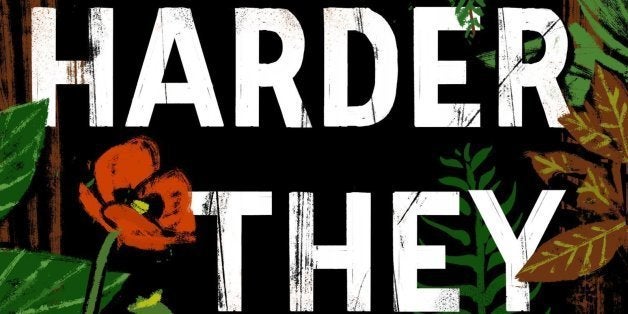
The Harder They Come
by T.C. Boyle
Ecco, $27.99
Published March 31, 2015
The Bottom Line is a weekly review combining plot description and analysis with fun tidbits about the book.
The Harder They Come opens with an act of violence. Sten Stenson, a 70-year-old veteran and retired school principal, has reluctantly joined his wife, Carolee, on a nature walk in Costa Rica during a cruise to Central America. Their isolated tour group is set upon by armed hooligans staging a robbery of the wealthy American travelers, and Sten instinctually attacks the gun-toting leader, killing him.
Sten wrestles with guilt and shame over the outcome of his protective actions -- the young man who died was someone’s son, someone’s loved one -- but the local authorities don’t make much trouble for him. The dead criminal had a long rap sheet and was in the process of committing a crime; they don’t bother to detain his killer long or charge him with a crime for the homicide. Instead, he returns to his home in Mendocino an unwilling hero, feted by the media for his bravery.
Sten is also unwilling to deal with another problem waiting in California: his own young son, Adam, who has long suffered from delusions and outbursts of violent misbehavior. Now an adult, Adam is beyond Sten and Carolee’s control, off his medication, and withdrawing into his own paranoid world. He cultivates a secret plantation of opium in the woods, trading the drugs for supplies, and self-soothes with hard liquor and weed. His role model is the first so-called mountain man, John Colter, a member of Lewis and Clark’s expedition; he insists on being called “Colter” and pushes himself to feats of outdoorsmanship equal to the original’s 11-day barefoot hikes and daring escapes from hostile American Indians.
When he hitches a ride with Sara, a right-wing extremist who shares his paranoid fear of the government, the two fall in together. The lonely older woman becomes his lover, and, Boyle repeatedly suggests, a surrogate mother figure. She feeds him, overlooks his unsettling eccentricities, provides him with physical intimacy, and attempts to curb his more destructive impulses.
This uneasy balance cannot hold, however. The Stensons have sold Carolee’s late mother’s house, where Adam has lived alone since her death, and when he’s finally forced to leave, his tenuous hold on reality snaps. Like Colter, he retreats to the woods with his supplies and Chinese assault rifle, seeking shelter in bunkers beneath the ancient redwoods. Local men patrolling the woods for illicit growing operations stumble across his hideouts, and Adam shoots without hesitation. His bullets leave two men dead, launching a massive manhunt that shuts down the whole mountain as he expertly eludes and outflanks local law enforcement.
Boyle weaves together a dark tapestry of thematic threads -- state-sanctioned violence, drug crime, environmental devastation, and xenophobic hatred -- that place every character in morally murky territory. With so many values to uphold, some conflicting, no one can avoid sinning, and the only question is which sins will be allowed to pass. Boyle doesn’t overly belabor the parallels between Adam and the young Costa Rican Sten kills in the act, or between Adam and Sten himself, but the thoughtfully juxtaposed moments of violence and their consequences invites readers to draw their own conclusions.
The writing, though stodgily assured, threatens to choke these provocative insights at times. Boyle has won the Henry David Thoreau award for nature writing, with good reason; his prose is observant, patient. In dealing with the quirks of humanity, however, it can often come out stiff and over-worked: “the injustice of it all settling on her like a coat made out of lead, like one of those things they make you wear when they take X-rays of your chest.” The pages pile up with metaphors, similes, lavishly described details, too many of which do more to take up space than they do to advance our understanding of the characters or narrative.
Though Sara, Adam’s lover, features prominently in the book, she never seems to cohere into one character: a soft, nurturing, diet-obsessed peacenik one page, then the hardened, rebellious political extremist the next. Adam’s own sections, told in a tight third person like those focused on Sara and Sten, make use of a looser, more rambling style to reflect his schizophrenic thinking, but still highly logical and polished for what’s presented as the viewpoint of a man in the throes of a violent psychotic break.
Despite its stylistic limitations, The Harder They Come is a powerfully unsettling read, especially in a time of growing concerns about unchecked gun violence and the deadly consequences of the war on drugs.
The Bottom Line:
The Harder They Come surveys the grim toll of our societal attitudes toward violence, drugs, and mental illness in a powerful but stylistically flawed novel.
What other reviewers think:
NPR: "In Harder, he's perfected his timing, using the same gimmick over and over again where a day begins soft and slow, then gradually twists and tightens until something has to break. And it works because, again, Boyle writes heavy that feels light."
Los Angeles Times:"If Boyle has created any problem for himself, it's this: Much of his story is tied to characters, Adam and Sara, whose irrational, far-right, Uh-merican ignorance (or outright insanity) make them hard to follow with anything like sympathy. Even as the action amps up, emotional connection flickers."
Who wrote it?
T.C. Boyle has written 14 novels, including the PEN/Faulkner award-winning World’s End, and 10 short story collections. He is an English professor at the University of Southern California
Who will read it?
Readers who enjoy detailed prose and realist fiction exploring American life.
Opening lines:
“There was no slant to the sun -- it was just there, overhead, burning, making him sweat, making his underwear bind and the shirt stick to his back as if it had been glued on, and why he’d ever let Carolee talk him into this he’d never know.”
Notable passage:
“And where was Adam, where was he, no shape or shadow of him in the passenger’s seat as she jerked the driver’s door and flung her things in, calling ‘Adam! Adam!’ in a hot fierce whisper that sounded in her own ears like a scream. Her fingers trembled as she rifled through the purse for her keys and then she had them in the ignition and the engine jumped to life and the headlights flew out like heat-seeking missiles and there he was, Adam, right there in front of the car, the rifle tucked under one arm and the twin pinpoints of his eyes throwing the light back at her.”
